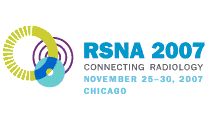
Abstract Archives of the RSNA, 2007
SSA15-07
Effect of Computer-aided Diagnosis (CAD) on Radiologistsí Characterization of Lung Nodules on CT: An ROC Study
Scientific Papers
Presented on November 25, 2007
Presented as part of SSA15: Physics (Thoracic CAD )
Ted Win Way, Presenter: Nothing to Disclose
Heang-Ping Chan PhD, Abstract Co-Author: Nothing to Disclose
Jadranka Stojanovska-Nojkova MD, Abstract Co-Author: Nothing to Disclose
Luba Frank MD, Abstract Co-Author: Nothing to Disclose
Thomas Kieju Song MD, Abstract Co-Author: Nothing to Disclose
Ella A. Kazerooni MD, Abstract Co-Author: Consultant, General Electric Company
Consultant, Vital Images, Inc
Philip Neil Cascade MD, Abstract Co-Author: Nothing to Disclose
Aamer Rasheed Chughtai MBBS, Abstract Co-Author: Nothing to Disclose
Chad Poopat MD, Abstract Co-Author: Nothing to Disclose
Anil Kumar Attili MBBS, Abstract Co-Author: Nothing to Disclose
Berkman Sahiner PhD, Abstract Co-Author: Nothing to Disclose
Lubomir M. Hadjiiski PhD, Abstract Co-Author: Nothing to Disclose
et al, Abstract Co-Author: Nothing to Disclose
et al, Abstract Co-Author: Nothing to Disclose
To evaluate the effect of computer-aided diagnosis (CAD) on radiologists’ estimates of the likelihood of malignancy of lung nodules on CT.
We developed an automated CAD system to characterize lung nodules. The CAD system segmented the nodule in a volume of interest and extracted morphological, texture, and gradient field features. Stepwise feature selection with simplex optimization in a leave-one-case-out training and testing scheme was used to select effective features. The features were then input to a linear discriminant classifier to estimate a malignancy rating for the nodule. We conducted an observer study with ROC methodology to evaluate the effect of CAD on radiologists’ characterization of lung nodules. 152 patient CT scans containing 256 nodules (124 malignant, 132 benign) were used with IRB approval. Pathology was established through biopsy, PET, presence of metastatic disease, or two-year follow-up. Six fellowship-trained thoracic radiologists served as readers. They were free to view the entire CT scan but were instructed to focus on rating the nodule of interest, which was enclosed in a box that had been previously marked by an expert thoracic radiologist who did not participate as an observer. A rendering of the volume was also available. The reading order of the individual nodules was randomized differently for each reader. Readers rated the likelihood of malignancy on a scale of 0-100% and recommended appropriate action first without CAD and then with CAD.
The CAD system achieved a test Az of 0.86±0.02 using three morphological, two texture, and two gradient field features. All 6 radiologists had improved performance with CAD, four reaching statistical significance (pAz of the radiologists improved significantly from 0.82 (range: 0.77-0.86) to 0.84 (range: 0.77-0.89) with CAD (p<0.01).
CAD has the potential to improve radiologists’ performance in assessing the likelihood of malignancy of lung nodules.
Improved diagnostic accuracy of lung nodules may improve early detection and treatment of lung cancer and reduce benign biopsies.
Way, T,
Chan, H,
Stojanovska-Nojkova, J,
Frank, L,
Song, T,
Kazerooni, E,
Cascade, P,
Chughtai, A,
Poopat, C,
Attili, A,
Sahiner, B,
Hadjiiski, L,
et al, ,
et al, ,
Effect of Computer-aided Diagnosis (CAD) on Radiologistsí Characterization of Lung Nodules on CT: An ROC Study. Radiological Society of North America 2007 Scientific Assembly and Annual Meeting, November 25 - November 30, 2007 ,Chicago IL.
http://archive.rsna.org/2007/5002812.html

